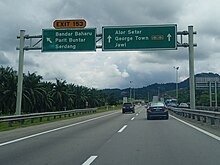Bandar Baharu
Due to its proximity to Penang, the Bandar Baharu District is considered to be part of Greater Penang, Malaysia's second-largest conurbation. The district's logistical needs are met by Penang's transportation infrastructure.
The Bandar Baharu District Council (Majlis Daerah Bandar Baharu, MDBB) administers the district. This district covers an area of 168.3 km and consists of seven sub-districts: Serdang, Kuala Selama, Sungai Batu, Bagan Samak, Permatang Pasir, Sungai Kecil Ilir and Relau. Serdang, a 20 km drive away from the town of Bandar Baharu, is the district capital and administrative center of the Bandar Baharu District. The district is the southernmost and second smallest local government area in Kedah.
The district borders the South Seberang Perai district to the east, the Larut, Matang and Selama and Kerian districts in the south and the Kulim district to the north.
Administrative divisions

Bandar Baharu District is divided into 6 mukims (administrative divisions), which are:
Sub-districts
- Serdang
- Taman Serdang
- Taman Aked
- Taman Cempaka
- Taman Kenanga
- Taman Melur
- Perumahan Awam 1
- Perumahan Awam 2
- Kampung Sungai Punti
- Kampung Ayer Itam
- Kampung Badlisha
- Kampung Bangol Durian
- Kampung Bangol Limau
- Kampung Baru Serdang
- Kampung Batu 8
- Kampung Batu 10
- Kampung Batu 12
- Kampung Batu 16
- Kampung Batu 18
- Kampung Batu Ayer Putih
- Kampung Batu Hampar
- Kampung Batu Lintang
- Kampung Bendang Sera
- Kampung Bukit Aping
- Kampung Bulikt Buluh
- Kampung Cina
- Kampung Chelong
- Kampung Durian Burung
- Kampung Ee Guan
- Kampung Jalan Selama
- Kampung Jermai
- Kampung Kuala Air Puteh
- Kampung Kuala Dingin
- Kampung Leret
- Kampung Medan
- Kampung Paya Salak
- Kampung Pekan Lama
- Kampung Setali
- Kampung Sungai Buluh
- Kampung Sungai Kasai
- Kampung Sungai Saleh
- Kampung Sungai Setol
- Kampung Sungai Taka
- Kampung Sungai Tegas
- Kampung Sungai Tegas Terap
- Kampung Telok Kelian
- Kampung Telok Sera
- Kampung Tengah
- Kampung Terap
- Kampung Titi Akar
- Ladang Chim Khoon
- Ladang Somme
- Ulu Riau
Bagan Samak
- Bandar Baharu
- Kampong Permatang Kerat Telunjuk
- Kampong Baru Bagan Samak
- Kampung Kubu, Parit Nibong
- Kampung Sg. Tepus/Pasir Debu
- Kampung Bukit Aping
- Kampung Parit Teropong
- Kampung Sg. Kechil Ulu
- Kampung Parit Nibong/Asam Kumbang
- Kampung Bagan Samak
- Kampung Rumah Murah/Tebuk Mat Rashid
- Kampung Lubok Buntar
- Kampung Berjaya Batu 26
- Kampung Permatang Simpor
- Kampung Permatang Pasir
- Taman Berlian Indah
- Taman Cahaya Nilam
- Taman Cahaya Intan
- Taman Kelisa Emas
- Taman Impian Casa Mutiara
- Taman Cahaya Kristal
- Taman Sejahtera
- Taman Sentosa
Sungai Batu
- Kampung Kuala Dingin
- Kampung Sg. Itam Dalam
- Kampung Sg. Tengas
- Kampung Terap Dalam
- Kampung Seribu Relong
- Kampung Baru Selama
- Kampung Selama Luar
- Kampung Sungai Tengas Ilir
- Kampung Chong Meng
Relau
- Kampong Tengah Relau
- Kampong Ulu/Relau
- Kampong Padang
- Kampong Sungai Rambai
- Kampong 300 Kaki Relau
- Kampong Kilang Batu
- Kampong Paya Semambu
- Taman Relau Indah
Sungai Kechil Ilir
- Kampung Belakang Pekan (Kampung Masjid)
- Kampung Keda
- Kampung Balai Lama
- Kampung Padang
Demographic
| Year | Pop. | ±% | ||
|---|---|---|---|---|
| 1991 | 33,006 | — | ||
| 2000 | 37,963 | +15.0% | ||
| 2010 | 41,352 | +8.9% | ||
| 2020 | 44,412 | +7.4% | ||
| ||||
| Source: | ||||
Tourism And Recreation
- Seri Tasik Park
- This park in Serdang town was originally an inactive mine that was redeveloped as a recreation garden with a children’s playground and exercise equipment with a budget allocated by the National Landscaping Department. A budget for further development from the Ministry of Culture, Art and Tourism of Malaysia was granted for the construction of a new wakaf (traditional wooden pavilion); providing picnic tables and chairs; building concrete bridges to link two lakes; a new pedestrian pathway; and decorative lights around the park.
- Batu Hampar Recreation Jungle Air Puteh, Serdang
- Kerian River Bank
- Sawah Padi
- Bagan Samak
Federal Parliament and State Assembly Seats
| Parliament | Seat Name | Member of Parliament | Party |
|---|---|---|---|
| P18 | Kulim-Bandar Baharu | Roslan Hashim | Perikatan Nasional (BERSATU) |
| Parliament | State | Seat Name | State Assemblyman | Party |
|---|---|---|---|---|
| P18 | N35 | Kulim | Wong Chia Zhen | Perikatan Nasional (GERAKAN) |
| P18 | N36 | Bandar Baharu | Muhammad Suffian Yusoff | Perikatan Nasional (PAS) |
Transportation

Car
PLUS ![]() North–South Expressway Northern Route exit 153 serves Bandar Baharu.
North–South Expressway Northern Route exit 153 serves Bandar Baharu.
Public transportation
KTM Intercity does not directly enter Bandar Baharu. The closest station is in Parit Buntar, Perak.
References
- ^ "Laman Web Rasmi Pejabat Daerah Bandar Baharu - Mengenai Kami". pdbb.kedah.gov.my. Archived from the original on 2017-12-01. Retrieved 2017-11-26.
- ^ "Population Distribution and Basic Demographic Characteristics, 2010" (PDF). Department of Statistics, Malaysia. Archived from the original (PDF) on 22 May 2014. Retrieved 19 April 2012.
- ^ "Warga Kedah Sifatkan Keputusan MB Tukar Nama Bandar Baharu Sebagai 'Penyundalan' Bahasa Melayu". Suara.tv. Archived from the original on 2 March 2016. Retrieved 18 February 2016.
- ^ "Key Findings of Population and Housing Census of Malaysia 2020" (pdf) (in Malay and English). Department of Statistics, Malaysia. ISBN 978-967-2000-85-3.
External links
- MDBB Archived 2014-09-14 at the Wayback Machine
- District Map
- Map
- Bandar Baharu District